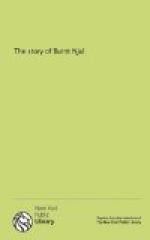[Footnote 49: “Hero’s helm-prop,” the hero’s, man’s, head which supports his helm.]
[Footnote 50: It is needless to say that this Hall was not Hall of the Side.]
[Footnote 51: “Wolf of Gods,” the “caput lupinum,” the outlaw of heaven, the outcast from Valhalla, Thangbrand.]
[Footnote 52: “The other wolf,” Gudleif.]
[Footnote 53: “Swarthy skarf,” the skarf, or pelecanus cardo, the cormorant. He compares the message of Thorwald to the cormorant shimming over the waves, and says he will never take it. “Snap at flies,” a very common Icelandic metaphor from fish rising to a fly.]
[Footnote 54: Maurer thinks the allusion is here to some mythological legend on Odin’s adventures which has not come dawn to us.]
[Footnote 55: “He that giant’s,” etc., Thor.]
[Footnote 56: “Mew-field’s bison,” the sea-going ship, which sails over he plain of the sea-mew.]
[Footnote 57: “Bell’s warder,” the Christian priest whose bell-ringing formed part of the rites of the new faith.]
[Footnote 58: “Falcon of the strand,” ship.]
[Footnote 59: “Courser of the causeway,” ship.]
[Footnote 60: “Gylfi’s hart,” ship.]
[Footnote 61: “Viking’s snow-shoe,” sea-king’s ship.]
[Footnote 62: “Boiling Kettle,” This was a hver, or hot spring.]
[Footnote 63: This was the “Raven’s Rift,” opposite to the “Great Rift” on the other side of the Thingfield.]
[Footnote 64: “Warrior’s temper,” the temper of Hauskuld of Whiteness.]
[Footnote 65: “Snake-land’s stem,” a periphrasis for woman, Rodny.]
[Footnote 66: “He that hoardeth ocean’s fire,” a periphrasis for man, Hauskuld of Whiteness.]
[Footnote 67: “Baltic side.” This probably means a part of the Finnish coast in the Gulf of Bothnia.]
[Footnote 68: “Wild man of the woods.” In the original Finngalkn, a fabulous monster, half man and half beast.]
[Footnote 69: “Sand,” Skeidara sand.]
[Footnote 70: “Sand,” Maelifell’s sand.]
[Footnote 71: “Nones,” the well-known canonical hour of the day, the ninth hour from six A.M., that is, about three o’clock P.M., when one of the church services took place.]
[Footnote 72: “Son of Gollnir,” Njal, who was the son of Thorgeir Gelling or Gollnir.]
[Footnote 73: “My friends,” ironically of course.]
[Footnote 74: “Helmet-hewer,” sword.]
[Footnote 75: John for a man, and Gudruna for a woman, were standing names in the Formularies of the Icelandic code, answering to the “M or N” in our Liturgy, or to those famous fictions of English Law. “John Doe and Richard Roe".]
[Footnote 76: “Gossipry,” that is, because they were gossips, God’s sib, relations by baptism.]
[Footnote 77: “Swinestye,” ironically for Swinefell, where Flosi lived.]




